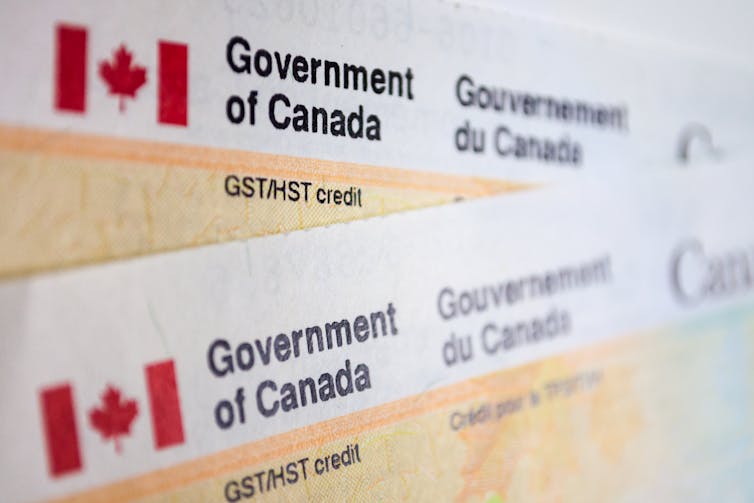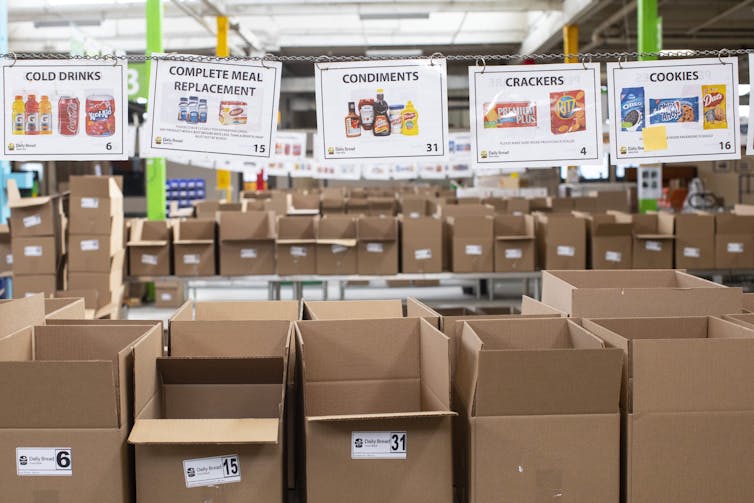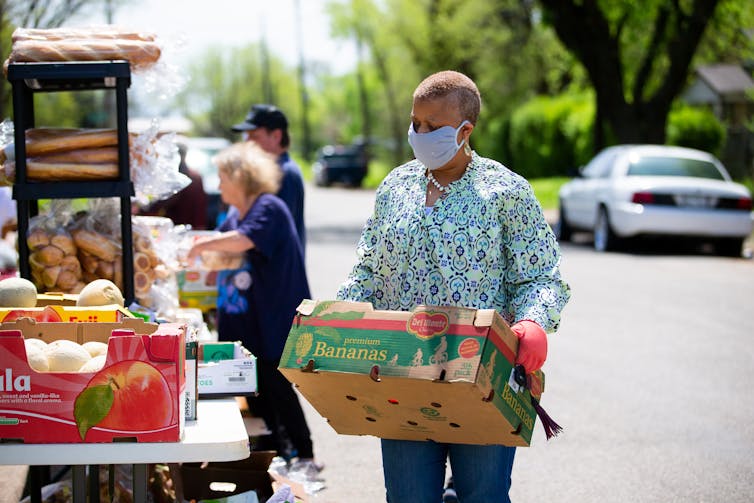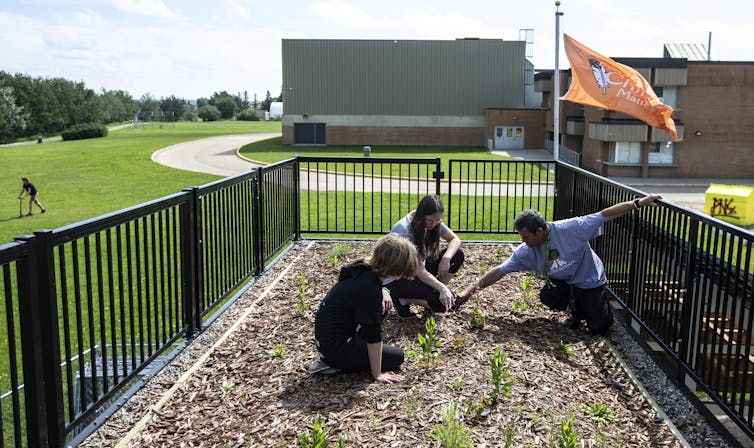
USA & CANADA (847)
Latest News
Wildfire preparedness and response must include planning for unhoused people and other vulnerable populations
Wednesday, 07 June 2023 09:49 Written by THECONVERSATIONThe 2023 Canadian wildfire season is off to a roaring start. In Alberta, there have been more than 560 wildfires so far — the highest recorded number of fires since 2018, and the season has only just begun. Tens of thousands of residents have been evacuated and a state of emergency was declared across the province.
Wildfires are not new to the region. The 2016 Horse River/Fort McMurray Wildfire was the worst wildfire and most costly disaster in recent Canadian history. Meanwhile, on the opposite side of the country, Nova Scotia has already experienced a historic 200 wildfires, resulting in a local state of emergency in Halifax Regional Municipality and more than 25,000 displaced residents.
As public health and disaster management scholars, our research focuses on how best to support the health of vulnerable populations in adverse situations, including through disasters, political challenges and geographic isolation. We have been devastated watching news coverage of the recent wildfires, including in one of our home provinces. However, we are not shocked.
With the impacts of climate change, wildfires in Canada will continue to intensify in strength and frequency. Enclosed shelter is paramount in reducing exposure to wildfire smoke. Yet, what happens to the nearly 35,000 unhoused Canadians on any given night who cannot easily evacuate or shelter indoors?
Impact on the unhoused
Research suggests that unhoused people are most vulnerable in disasters as they are often the first to experience them and often do not have the ability to prepare or alleviate their risks. In particular, studies show unhoused people’s disproportionate risks to health during heat events and wildfire due to limited access to appropriate shelter.
Many unhoused people have pre-existing health issues that can be worsened during disasters. These include substance use disorder, mental illness and chronic conditions. For people with a substance use disorder, there can be significant disruptions to accessing treatment medications and inequities in opioid-related deaths in communities vulnerable to disasters.
Even for unhoused people outside of evacuated communities, poor air quality caused by wildfire smoke can cause heat stroke, dehydration and respiratory illness.
Despite these unique harms, unhoused people have limited access to resources and supports that facilitate evacuation and post-disaster recovery. Both Alberta and Nova Scotia have relied on the use of emergency alerts, yet many unhoused people do not have access to technology for emergency alerts and are not eligible for disaster relief support.
Evacuation centres are open to all, yet stigma and mistrust of authorities can prevent access for the unhoused. Furthermore, research shows that authorities tend to provide more support for those who have lost their housing due to wildfires than those who were previously unhoused.
Planning for unique risks
As many Canadian provinces are currently experiencing, extreme heat and wildfires are increasing in frequency and intensity.
Loss of housing and infrastructure compounds an already fragile housing environment, especially for renters and Indigenous populations. A lack of affordable housing, aggravated by disasters, further reduces the likelihood that people living precariously will secure permanent housing, which would better protect them during future wildfire seasons.
Although cooling centres open during extreme heat, there are few respite centres during periods of low air quality, particularly in the evening. Looking at other provinces, Housing BC and End Homelessness Winnipeg are working towards ensuring unhoused people are supported during extreme heat and wildfire smoke. However it is unclear how unhoused populations are being helped during the current wildfires.
Our concern as researchers is that there is an alarming lack of international, national and provincial plans or guidelines that consider the unique risks and needs of unhoused populations during wildfires.
What is apparent is that response often falls on service providers who support the unhoused, despite adequate housing being an international human right that should be the responsibility of the government.
Support during disasters
It is imperative for all levels of the Canadian government to consider how to best support unhoused people during disasters.
Looking at international responses to other disasters, promising practices include trauma-informed and addictions/mental health training for emergency responders and evacuation personnel, outreach services, developing inclusive materials for preparedness and response (for example, flyers and handouts), providing inclusive low-barrier evacuation spaces, and dedicating resources to post-disaster recovery and support for the unhoused.
Most importantly, any response must involve a co-ordinated partnership between community organizations, the government and those with the experience of being unhoused.
We need to better prepare for Canada’s wildfire season by including high risk and extremely marginalized populations, such as those who are unhoused, in emergency management plans and practices. Greater consideration of high-risk populations will ensure no one gets left behind.![]()
Holly Mathias, PhD student, School of Public Health, University of Alberta and Ashleigh Rushton, Postdoctoral Fellow, Health Sciences, University of The Fraser Valley
This article is republished from The Conversation under a Creative Commons license. Read the original article.
As the U.S. expands work conditions for income assistance, Canada takes a different tack
Wednesday, 07 June 2023 09:46 Written by THECONVERSATION 
Wayne Simpson, University of Manitoba
Only days before a government default, United States President Joe Biden and House Speaker Kevin McCarthy reached an agreement to raise the country’s debt ceiling and avoid financial turmoil.
One important feature of this agreement is an expansion of the work requirements for recipients of Medicaid and food stamps. These new work conditions could affect millions of low-income Americans.
The expansion would limit childless able-bodied adults between 18 and 55 to only three months of assistance every three years unless they meet certain work-related criteria, like working at least 20 hours a week.
But while attaching work conditions to social assistance has been the norm for U.S. federal income assistance for a very long time, this hasn’t always been the case.
U.S. work conditions for assistance
The U.S. War on Poverty provided the impetus for former president Richard Nixon to propose the Family Assistance Plan in 1969 to alleviate poverty and welfare dependence.
The plan involved a negative income tax that would have provided $500 per adult and $300 per child — regardless of work conditions — to families without other income.
Legislation was passed with bipartisan support in 1970, but encountered opposition in the Senate because of concerns about work disincentives and welfare dependency. These concerns could not be alleviated by preliminary evidence of an insignificant work response in the New Jersey Income Maintenance Experiment.

The Family Assistance Plan was eventually replaced with the Earned Income Tax Credit, which only provides assistance by topping up the earnings of low-income Americans. It effectively attaches work conditions to federal income assistance.
The Earned Income Credit has grown in popularity through successive U.S. administrations with enhanced benefits, expanded coverage and advanced regular payments.
As the major program of cash support for low-income families, it works in concert with the federal food stamps program administered by states according to requirements and funding.
It’s therefore unsurprising that moves to tighten requirements for food stamps and Medicaid would rely on more stringent work conditions.
Canada’s alternative approach
While work conditions have long been the norm for U.S. federal support programs, Canada has taken a different path. Even before Nixon’s Family Assistance Plan, Canada had instituted the Guaranteed Income Supplement for seniors in 1967.
Like the Family Assistance Plan, it was designed as a negative income tax to supplement the Old Age Security benefits for low-income seniors.
The minister of national health and welfare at the time, Allan MacEachern, introduced the measure as a “simple, acceptable and effective” guaranteed income.
While work conditions were of little concern for the senior population, MacEachern noted the supplement could encourage work for those who sought it.
The supplement expanded over time and contributed to reducing seniors’ poverty in Canada to rates that were among the lowest in the world.
The federal sales tax refundable credit followed in 1986. It remains modest, but has been boosted recently to assist low-income families in the inflationary aftermath of the pandemic.
More substantial is the refundable child tax credit, introduced as a modest benefit in 1978 but expanded to the modern Canada Child Benefit in 2016. It lifted a significant number of families with children out of poverty almost immediately.
The common thread in the construction of this federal income support network has been the absence of work conditions. An American-style earned income tax credit was introduced in 2008, but it remains modest.
Recent research exploring the potential expansion of this credit as a replacement for social assistance and most other existing tax credits showed that it would reduce poverty for families and working-age singles. However, it would have significantly less overall poverty impact than similarly priced guaranteed income models that don’t have work conditions.
Are work conditions needed?
Work conditions have been at the heart of opposition to income support policies for a very long time. Concerns that a negative income tax would discourage recipients from working was front and centre in the design, conduct and analysis of guaranteed basic income experiments in the U.S. and Canada in the 1970s.
The experiments provided evidence of modest discouragement towards work, and subsequent basic income pilot projects and other similar studies have not changed this perspective. For example, there is no evidence of an adverse work response to the Canada Child Benefit.

But despite this evidence, work conditions remain a sticking point for federal aid in the U.S. — not only among Republicans, but among swing-vote Democrats and the public at large. This suggests federal aid work conditions will remain in place in the U.S.
By their very nature, work conditions likely provide some encouragement to low-income families to find employment to qualify for benefits. The U.S. Earned Income Tax Credit slightly improves female labour force participation.
By design, however, federal programs with work conditions attached are unlikely to improve deep poverty.
Work conditions remain for welfare
The distinction between the U.S. and Canada’s approaches don’t extend beyond federal income assistance. Work conditions and other bureaucratic measures still dominate at the state and provincial level, despite significant federal funding support.
Temporary Assistance for Needy Families in the U.S. strengthened requirements for job searching and work-like activities, despite evidence that bureaucratic measures already in place reduced welfare participation.
In Canada, provinces still employ a complex bureaucratic machinery to receive claims, assess eligibility, deliver benefits, impose work conditions, police fraud and non-compliance, determine and recover over-payments, provide social services and report to authorities.
While there is little impetus to remove work conditions and other bureaucratic controls in the U.S., there is some movement to reduce barriers to welfare participation in Canada.
Most notably, the Prince Edward Island legislature has affirmed their support for a basic income to replace current welfare assistance in the province. This would separate receipt of welfare benefits from employment services and other work conditions imposed elsewhere.![]()
Wayne Simpson, Professor, Department of Economics, University of Manitoba
This article is republished from The Conversation under a Creative Commons license. Read the original article.
President Joe Biden, 80, takes a tumble on the stage during Air Force Academy graduation (Video)
Sunday, 04 June 2023 01:27 Written by lindaikeji US President Joe Biden, 80, took a tumble on the stage during Air Force Academy graduation on Thursday, June 1. Afterwards, he sat back down and appeared to be fine. White House communications director Ben LaBolt later explained on Twitter that the mishap occurred because there was a sandbag on the stage.
The fall happened during the U.S. Air Force Academy graduation ceremony in Colorado Springs, where Biden delivered the commencement address. Biden was helped back up and pointed out that he had tripped over something.
'%20class='img-responsive%20text-center'%20style='margin:%20auto;'/img%20alt='President%20Joe%20Biden,%2080,%20%20takes%20a%20tumble%20on%20the%20stage%20during%20Air%20Force%20Academy%20graduation%20(Video)'%20class='img-responsive%20text-center'%20style='margin:%20auto;'/2023/06/02/550x309/Screenshot_2023-06-02_073527_1685671536156_1685671566251.png)


As governments shirk their responsibilities, non-profits are more important than ever
Wednesday, 31 May 2023 08:08 Written by theconversation 
Kevin Gosine, Brock University; Darlene Ciuffetelli Parker, Brock University, and Tiffany L. Gallagher, Brock University
You’ve likely walked past that non-profit youth centre or literacy program in your neighborhood countless times. You’ve probably never needed to make use of it and never given it a second thought.
But on your next stroll, take a moment to consider the work that organization does, the challenges it faces and the vast benefits it brings to your community.
In an age of proliferating social troubles and government retreat, Canadians must be aware of the critical role played by the non-profit sector.
Recent decades have seen the welfare state withdraw in favour of free-market principles. In a neoliberal era, where profitability is prioritized over social duty, all orders of government in Canada have shirked much of the responsibility for providing social services onto non-profits.
Importance of social connections
As non-profits have become saddled with more obligations, they are handcuffed by limited funding. Long-term funding arrangements between governments and non-profits have been replaced by provisional and competitive funding. While non-profits are expected to do significantly more, they are relegated to coping with far fewer resources.
This has serious implications for the long-term well-being of communities, especially those already marginalized and under-served.
Not only are non-profits now providing critical services and social supports for which the state previously took responsibility, they are also settings where vital forms of social capital are produced.
Social capital refers to networks of trust, belonging and support developed among people within a given community (bonding social capital), and between people who identify with different communities or social groups (bridging social capital). Social capital enables people to work together toward mutual well-being and goal attainment.

Social capital doesn’t just happen
Communities must find ways to create worthwhile forms of social capital. And that’s where non-profit organizations can fill a gap. However, constantly scrambling for money leaves these organizations little time, resources and capacity to provide programming that fosters social capital.
Our research on community literacy organizations illuminated the role of non-profit organizations in helping people cultivate social capital. We conducted interviews and focus groups with program leads, staff and service users at eight non-profit organizations in southern Ontario to learn how they support literacy in their communities.
We found that producing social capital enabled them to serve communities in ways that transcended their primary mandates.
It is unrealistic to expect people to build social capital on their own, devoid of enabling social infrastructure. The challenge of creating meaningful social connections is daunting. Especially as society becomes increasingly individualistic. Religion — once a stalwart source of community — continues to decline and technology is rapidly displacing face-to-face human interaction. Urban planners and community stakeholders need to provide the settings and opportunities for people to come together, connect and collaborate.
We found that non-profit community programs serve as settings where people from marginalized backgrounds can build beneficial forms of social capital. Such local initiatives provided individuals with recurrent and predictable channels to interact, share lived experiences and work together.
For example, mothers of children with disabilities participated in self-help groups where they shared their experiences, exchanged information and generally supported one another. Civic projects, such as a community garden started at one organization, brought together residents, young and old.
Non-profit programs provide people with opportunities to interact with different community members and forge meaningful interactions with people outside their social group that mitigate prejudice and foster trust and understanding.

Over the course of our research, we saw what started as bridging social capital strengthen into bonding ties between program participants, and in many cases between program users, staff and volunteers. The significance of these bonds was powerfully conveyed by one participant who took part in our study:
… what I take away from this group [is] that there are good people still left in a world that’s so scary, and people that are there to support. And whether I’m here or not, they’re always willing to help somebody else that’s in need. And… knowing that the option of … being there and the people that come together for this group–it’s really incredible to know that you have somebody.
The programs we studied connected individuals to new people, organizations, supports and resources and provided ongoing opportunities to build bridging social capital.
While the primary purpose of the non-profit organizations was to improve literacy, these programs accomplished much more. By providing a judgement-free safe space where participants had opportunities to share and collaborate, these organizations fostered social capital within communities.
The community organizations we studied had recently lost their primary funding provided by a regional anti-poverty program. Program leads and staff remained committed to supporting service users but struggled to do so given the need to devote more time and resources to addressing funding insecurities.
Benefits of social capital
When social capital is actively fostered, social trust is elevated. Research has demonstrated that the more non-profit organizations there are in a community, the lower the crime rate. Non-profit organizations help to lessen crime by enhancing levels of social capital and trust and expanding opportunities and hope.
Strengthening people’s social and organizational ties broadens their horizons and improves their well-being. Non-profits play a crucial role in fostering and sustaining such social capital.
If governments expect communities to be viable and fend for themselves amid diminishing public support, local non-profits cannot be relegated to financial precarity. By starving the non-profit sector, governments are ironically undermining the capacity of communities to live up to the neoliberal ideals of self-reliance and local resourcefulness.![]()
Kevin Gosine, Associate Professor, Department of Sociology, Brock University; Darlene Ciuffetelli Parker, Professor, Department of Educational Studies; Director, Teacher Education, Brock University, and Tiffany L. Gallagher, Professor, Department of Educational Studies and Director, Brock Learning Lab, Brock University
This article is republished from The Conversation under a Creative Commons license. Read the original article.
Popular News
Dismay over King Charles’s coronation raises questions about Canada’s ties to the monarchy
Monday, 15 May 2023 04:45 Written by theconversation 
Jeffrey B. Meyers, Kwantlen Polytechnic University
The coronation of King Charles was a cringe-inducing display of white European hereditary privilege and ostentation that angered many, both in the United Kingdom and the Commonwealth.
That anger, or in some cases simple apathy or collective eye-rolling, should not be ignored because the monarchy and the Crown are not merely symbols, they’re a massive expense.
The cost of the coronation to the British taxpayer has been estimated at £100 million (almost $170 million in Canadian dollars) — extremely costly in a post-Brexit period of economic uncertainty and decline for the U.K..
Some of the vast private wealth and land holdings of the Royal Family are also connected directly to England’s role in colonization and the slave trade.
Despite all this, the monarch remains the head of state for many Commonwealth countries, including Canada.

The U.S. style of republicanism
While the American experiment in republicanism isn’t looking especially good at the moment amid the shambles left by Donald Trump’s presidency, the country’s founders were correct in recognizing that democratic legitimacy and monarchical power cannot be easily reconciled.
In fact, their biggest mistake and that of subsequent generations may simply have been to permit the presidency to retain elements of absolute or unfettered power in the form of executive privilege.
From George W. Bush’s disastrous war on terror to the Trump administration’s outright repudiation of democratic norms, recent presidents have not hesitated to behave like kings.
In Canada, we can benefit from both the lessons of the United States and the U.K. to avoid idealizing a republic with a powerful president and at the same time acknowledging that a traditional monarchy, even a purely symbolic or constitutional monarchy, is no alternative.
As I have argued before, each Commonwealth nation would have different legislative and constitutional processes to follow to sever ties with the British monarchy. Canada’s in particular would be complex and difficult, but not necessarily impossible.
It would require unanimous consent of all provincial legislatures and the federal Parliament. In practice, this would probably not be possible without referendums in each province. Because of this, some leading constitutional lawyers in Canada regard the question as a non-starter.
But if Canadians aren’t careful, they may one day find that events in the U.K. make the decision for us.
Here’s how.
Different political systems
Suppose current British demographic trends and polling data pan out and a decade or two from now a younger, more diverse British population loses patience with the monarchy.
Like Canada, the U.K. has a constitution and the monarchy is essential to it. But unlike Canada, the U.K.’s constitution is largely unwritten. Changing the British Constitution can at least theoretically be done by an ordinary act of Parliament and without the complexity of co-ordinating 10 sovereign legislatures.
Another difference? The U.K. is a unitary and not a federal state. This means British parliament, unlike Canada’s, can unilaterally amend its constitution to address the status of the monarchy if it wishes.
Similarly in the U.K., any conventions around public consultation would also be arguably less complex and more straightforward than in Canada because of the British system of government. This could lead to a bizarre situation in which the British monarch ceases to be the British head of state but remains the Canadian one.
To my knowledge, this would be a completely uncharted territory and a constitutional crisis of the highest magnitude.
Rather than continuing to sit nervously on the sidelines observing America’s presidential system lurch from crisis to crisis, or celebrating the coronation of Britain’s new king as our own, Canada should learn from the errors of both the republican model and monarchical model and do something different.

Looking ahead
We might start by recognizing forms of political association, governance and policymaking that are less European and owe more to Indigenous models.
Mary Simon, Canada’s governor general and the King’s representative in Canada — as well as first Indigenous person to occupy that colonial office — is correct when she says many Indigenous people look to the treaty relationship with the Crown, which predates Confederation itself, as part of their strategy of decolonization.
But it’s tough to reconcile a European hereditary monarchy with a Canada in which Indigenous people are attempting to take control over their own destiny.
Similarly, for many Canadians who immigrated to Canada from parts of the former British Empire in the Caribbean, Africa and India, finding the old colonial monarchy waiting for them here is no sign of dynamism.
It will be up to the current generation of Canadians to decide if now is the time to begin taking this question more seriously or whether to leave it to the United Kingdom to decide for us.![]()
Jeffrey B. Meyers, Instructor, Legal Studies and Criminology, Kwantlen Polytechnic University
This article is republished from The Conversation under a Creative Commons license. Read the original article.
King Charles III’s coronation oath is a crucial part of the ceremony – experts explain
Saturday, 06 May 2023 08:14 Written by theconversationThe crowning is perhaps the most famous part of British coronations. Yet easily overlooked – and equally important – is the coronation oath, which has been a fundamental component of the ceremony since medieval times.
It is of such significance that the remainder of the rite cannot proceed unless it has been sworn. Why? The oath is the essential counterpart to the recognition and acclamation.
The recognition is the moment at the beginning of the ceremony when the monarch is presented to the people for approval. The acclamation is the moment in which the people accept the new monarch.
Together, these three acts establish a contractual relationship between sovereign and peoples. By public commitment to the promises and values enshrined in the oath, the monarch is forming a bond to the largely uncodified constitution (the UK’s constitution has never been assembled into a single written document).
There has been talk of a shorter service for Charles III’s coronation. But to omit these vital stages would amount to constitutional vandalism.
Before primogeniture (the law of firstborn inheritance), the British monarchy was elective. In Anglo-Saxon times, the witan (the leading nobles or council of the country) chose the new sovereign. And until at least the middle ages, a secular enthronement, preceded the coronation service.
Today’s acclamation comes from that tradition of electing a sovereign. This is when the officiant (usually the Archbishop of Canterbury), standing with the candidate in Westminster Abbey, asks whether or not the congregation recognises the candidate’s entitlement to be crowned.

Those present acclaim the person as their monarch, crying “God save the King/Queen”, representing the country. Some historians contest the acclamation’s importance on the grounds that the respondents are unrepresentative of the people and unlikely to reject the candidate: “as if there was any choice in the matter”.
Nevertheless, it is vital to what follows that they are asked at all. In Portugal, under the Avis dynasty, the acclamation assumed such supreme importance that the crowning withered away altogether. By contrast, Russian peasants were never asked for consent to recognise a new Tsar.

This piece is part of our coverage of King Charles III’s coronation. The first coronation of a British monarch since 1953 comes at a time of reckoning for the monarchy, the royal family and the Commonwealth.
For more royal analysis, revisit our coverage of Queen Elizabeth II’s Platinum jubilee, and her death in September 2022._
Following the acclamation, the candidate must commit to their side of the contract – the terms set out in the coronation oath. “Coronation oath” is a slight misnomer. It is actually a series of promises in question and answer form, sealed by an oath sworn “in God’s presence”. The text of the promises has evolved, but the core has remained.
In the version lasting (with tweaks) from 1308 to 1685, the candidate promised to confirm the laws of their predecessors, to maintain peace, to administer impartial justice with mercy and to preserve and enforce the laws that parliament would pass.
The makings of a modern oath
The Glorious Revolution of 1688-1689 ushered in a major change when a revised oath became statutory. The version used for Queen Elizabeth II’s coronation in 1953 had three essential parts and retained the oath’s medieval core.
Firstly, would she promise: “to govern the Peoples … according to their respective laws and customs?” Secondly, would she cause: “Law and Justice, in Mercy, to be executed in all … [her] judgements?” Lastly would she: “maintain the Laws of God and the true profession of the Gospel” as well as “maintain in the United Kingdom the Protestant Reformed Religion established by law”?
Afterwards, came the oath proper. Elizabeth II swore:
The things which I have here before promised, I will perform and keep. So help me God.
As this shows, the monarch swears to uphold certain key values: law, justice and mercy (although Charles has said he sees himself as a “defender of faiths” and the service is likely to reference other denominations and religions).
That obligation speaks to the nation, but also broadcasts a global message of what the United Kingdom stands for.
The coronation oath marks the moment the monarch’s actions and words correspond to the trust placed in them by the people when they recognised and acclaimed them as their king or queen. Together, the two stages form a contract on the basis of which the service can proceed to the crowning.
There is a sense that uncrowned (and therefore unsworn) monarchs were, and are, not fully sovereign. Would Richard III have usurped the crown so easily had one of the princes in the tower been crowned? Might Lady Jane Grey (the nine-day queen) have seen off Mary Tudor if she had reigned long enough to undergo coronation? As it was, Mary I led the only successful coup d’état of the 16th century.
Writing of Edward VIII, who abdicated in 1936, the late Queen Mother commented that it was fortunate that “he was never crowned”. Clearly, an abdication post-coronation would have been more problematic because the coronation oath establishes accountability.
Breach of contract can, for a sworn monarch, have terrible consequences. The charge of flouting their coronation oaths was levelled against Edward II (deposed and murdered), Richard II (ditto), Charles I (deposed and executed) and James II (deposed and exiled). Those kings could not be trusted because they had broken their sacred word.
The oath is at once a conduit for tradition, a constitutional pillar, a source of legitimacy and authority and a marker of national values. The coronation oath binds monarch to peoples and to the governmental system of the state, but it also communicates some of the principles – law, justice and mercy – upon which that governance rests.
Oaths are still an important part of employment in the British armed services, police force, parliament, privy council and law courts. Each of those oaths mentions allegiance, service or loyalty to the sovereign. How incongruous it would be if the person at the summit of the constitutional pyramid had no oath to swear themselves.![]()
David Crankshaw, Lecturer in the History of Early Modern Christianity, King's College London and George Gross, Visiting Research Fellow, King's College London
This article is republished from The Conversation under a Creative Commons license. Read the original article.
National Day of Mourning offers Canada a chance to rethink worker health and safety
Saturday, 06 May 2023 08:11 Written by theconversation 
Julian Barling, Queen's University, Ontario and Alyssa Grocutt, Queen's University, Ontario
Canadians go to work each day expecting to return home safely, but for too many workers and their families, this expectation is unrealistic. According to the Association of Workers’ Compensation Boards of Canada, there were 1,081 workplace fatalities in 2021 alone.
Each year on April 28, Canadians remember and honour those who have been killed or suffered injuries or illness at work. This day, known as the National Day of Mourning, was established by the Canadian Labour Congress in 1984 and made official in 1991.
Four decades have passed since the National Day of Mourning’s first observance, and the annual toll from workplace fatalities in Canada continues to remain high. But just how deep and pervasive is the problem? And what can we do about it?
Widespread suffering
Those who consume news media can be forgiven for thinking the number of murders in Canada each year vastly exceeds the number of work-related fatalities. One reason for this is the excessive news coverage of murders relative to other causes of death like workplace fatalities.
The real numbers tell a different tale. About 700 people are murdered annually in Canada, while close to 1,000 people die at work each year. But one study from the Journal of Canadian Labour Studies argues the actual number could be 10 to 13 times greater.
The suffering goes well beyond the 1,000 workers who die each year. Within the workplace, colleagues who have witnessed horrendous tragedies are affected, as are leaders who have to break the awful news to family members and motivate surviving employees.
Outside the workplace, the emotional and financial burden on family members has been ignored for too long. What if the news media devoted as much attention to workplace safety incidents as we did to murders? Would the public demand that management, workers and government authorities work together to enhance workplace safety?

Myths about worker control
The National Day of Mourning presents us with an opportunity to reflect on workplace fatalities and the enormous toll they take on affected families, co-workers and organizational leaders, and commit to making a difference.
We can start by dispelling some major misconception that are inhibiting progress in workplace safety and health. One misconception among managers is that, because workplace safety is so important, every aspect of employees’ work requires control.
Yet, based on extensive interviews with senior managers and employees and an analysis of documentation from 49 manufacturing firms in the United Kingdom, researchers found the opposite is true.
Among the five key types of human resources approaches, only one was associated with fewer workplace injuries: higher levels of empowerment, which included autonomy and employee participation. Even managers that ceded small, incremental amounts of control to employees had a positive impact.
Myths about safety costs
A second common misconception is that government safety inspections can be costly; yet again research suggests otherwise.
According to a comparison of more than 400 workplaces that were not targeted for safety inspections in California, and an equal number that were randomly selected for inspections between 1996 and 2006, random safety inspections work.
Five years after random inspections, companies saw a 9.4 per cent reduction in injury rates, and a 26 per cent reduction in costs associated with the injuries.
These gains in safety were achieved without any cost to employment numbers, sales, credit rating or likelihood of firm survival, which are frequent concerns in the face of government safety inspections.
Given this, policymakers should feel reassured that increasing the number of safety inspectors is a wise investment in both injury reduction and cost reduction.

Myths about sick leave
The National Day of Mourning’s calls for reconsideration of workplace safety are particularly relevant in the era of COVID-19. The pandemic highlighted the misconception that paid sick leave hurts organizations.
Year-after-year, more people die at work from health-related issues, such as respiratory diseases and occupational cancers, than from safety incidents.
A 2020 study from Ontario’s Peel region revealed that 25 per cent of the employees surveyed went to work when they had COVID-19 symptoms; 88 workers even did so after being diagnosed with COVID-19.
Why? Because they could not afford to lose any pay. If we are to protect employee health and limit the spread of infection, we need to de-politicize perceptions around basic workplace programs such as paid sick leave.
Worker health programs and policies need to be implemented based on the best of evidence, rather than being a subject for negotiations between labour and management or the whims of the government.
Paid sick leave policies and programs are primary tools in preventing the spread of infections, thereby benefiting employees and protecting organizations and their communities. Employees should be reassured that they will not lose pay when they protect themselves and others by staying home when ill.
A new approach is needed
We need to change the widespread perceptions that workplace safety requires the tight grip of management, that random safety inspections hurt organizations and detract from profitability, and that paid sick leave is an expensive luxury.
On the contrary, employee autonomy and engagement, random safety inspections, and paid sick leave are some of the practices that management should welcome to develop safe and healthy workplaces.
Another small action that could have wide-ranging benefits is to change the very language of occupational safety. For too long, “workplace accident” has been the term used for any workplace safety incident or injury.
Why is this problematic? By definition, “accident” implies an event that is unpredictable, unplanned and uncontrollable. If that is indeed the case, we should be forgiven for not taking any action.
Yet post-injury and inquest reports tell us that the opposite is true: these incidents are invariably predictable, preventable and controllable. The time has come to change how we think about occupational health and safety.![]()
Julian Barling, Distinguished Professor and Borden Chair of Leadership, Smith School of Business, Queen's University, Ontario and Alyssa Grocutt, PhD Candidate in Organizational Behaviour, researching workplace safety, at Smith School of Business, Queen's University, Ontario
This article is republished from The Conversation under a Creative Commons license. Read the original article.
How schools and families can take climate action by learning about food systems
Saturday, 29 April 2023 13:15 Written by theconversation
Gabrielle Edwards, University of British Columbia
News about the climate crisis alerts us to the urgent need for drastic global changes. Given this, it’s not surprising that one study surveying thousands of young people found most respondents were worried about climate change, and over 45 per cent said worries about climate change affected them daily.
Young people are experiencing high levels of climate anxiety which is characterized by feelings of fear, worry, despair and guilt and can negatively affect psychosocial health and well-being.
Taking climate action is one proposed way to reduce climate anxiety by turning negative emotions in response to the reality of urgent challenges into positive action.
Engaging with food systems presents a major opportunity to act on the climate crisis, as they contribute 21 to 37 per cent of global greenhouse gas emissions. Both home-based discussions with parents or caregivers and school curriculums have a place in helping young people connect relationships with food to advocating for change to food systems or making more sustainable choices to benefit our shared planetary health.

What is a food system?
A food system includes everything that happens to food from farm to fork. The food system also includes all the people involved in each of those steps, including us.
Every time we eat, we participate in the food system. Yet, due in part to the increased number of steps between farm to fork, and the fact that in our dominant global economy food is positioned as a product to consume, there is a growing disconnect between people and the food system.
This disconnect has both contributed to current issues caused by food systems, and continues to perpetuate them. These issues include biodiversity loss, ecosystem degradation and global inequalities related to both labour practices and resource extraction.
Impact of daily choices
Many of us rarely consider the impact our daily food choices have on the environment. Those that do seldom see our own potential in engaging with and transforming the food system beyond eating on the basis of conscience.
Recognizing our role in the food system can be empowering, as it presents opportunities to act on the climate crisis.
Primary and secondary schools are a logical place to engage students in these issues as they are locations where young people spend most of their day and institutions that have goals of promoting an educated and engaged citizenry.
Despite the potential of educational institutions to engage young people in issues related to food systems, many school curriculums around the world, including throughout Canada, fail to do this.
Beyond nutrition, cooking
For example, research about primary school curriculums in 11 countries including Australia, England, Japan, Norway and Sweden finds that curriculums tend to focus on nutrition education or cooking skills with little to no mention of the ways current food systems are destroying our environment or perpetuating gross social injustices. Research about Canadian curriculums has similarly found curriculum policies tend to focus on eating in healthy ways as a matter of individual choice.
Although much curriculum does not take a holistic approach to food systems education, there are many third-party organizations that have created resources for educators examining food systems in a more comprehensive way.

Nutrition and cooking are important for individual health. But this limited focus can be disempowering for young people as it does not consider the positive impact people can have on transforming food systems to be more just and environmentally sustainable.
By showing the next generation ways to change our food systems for the better, we can not only reduce climate anxiety, but also ensure the next generation is equipped with the knowledge and skills to create a more just and sustainable future.
Taking action locally
So how do we support these important issues in our schools? If you are a concerned parent, you could join the parent advisory committee at your child’s school or write to your school district to find out if there are any positive local initiatives and to express concern.
You could also write to your provincial or territorial legislative representative to advocate for the inclusion of these issues in the curriculum.
Outside of school, parents or caregivers could find ways to engage children in discussions around food systems that go beyond nutrition. For school projects where a child has a choice about the topic, or as a home project, encourage your child to research different organizations in your area that are involved in sustainable food systems work. Together, visit a local farm or starting a small indoor or outdoor garden.
How a meal arrives on a plate
Another activity to start thinking about the global impact of food systems is to explore how a meal comes to be on your plate. You could ask questions like:
- What are the ingredients?
- Where in the world did all those ingredients originate?
- Who was involved in growing the ingredients, in transporting them and in creating the food being consumed?
- Were all those people treated fairly?
- Was the environment harmed in the production of the food?
Analyzing even a simple meal can lead to complex thoughts and discussions around food systems and reveal stark social and environmental issues.
By looking beyond nutrition, food can become a powerful tool to empower young people to take climate action which, in turn, can lead to reduced climate anxiety and increased feelings of hope for the future.![]()
Gabrielle Edwards, PhD Candidate in Curriculum Studies, University of British Columbia
This article is republished from The Conversation under a Creative Commons license. Read the original article.







